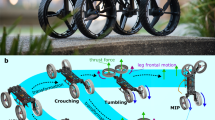Abstract
Segmented myriapod-like bodies may offer performance benefits over more common fixed body morphologies for ambulation. Here, the design of a segmented ambulatory microrobot with a flexible backbone is presented. A dynamic model describing the motion of the microrobot is used to determine body parameters. A three-segment microrobot was fabricated using the Smart Composite Microstructures process and piezoelectric bimorph actuators, and forward locomotion on a flat surface was demonstrated. The footprint of the 750 mg microrobot is 3.5 by 3.5 cm, and it has potential advantages over rigid body hexapedal microrobots in climbing, versatility, and stability.
Similar content being viewed by others
References
Anderson, B., Shultz, J., & Jayne, B. (1995). Axial kinematics and muscle activity during terrestrial locomotion of the centipede Scolopendra heros. J. Exp. Biol., 198(5), 1185–1195.
Baisch, A., & Wood, R. (2009). Design and fabrication of the Harvard ambulatory microrobot. In 14th int. symp. of robotics research.
Birkmeyer, P., Peterson, K., & Fearing, R. (2009). DASH: a dynamic 16g hexapedal robot. In Proc. IEEE/RSJ international conference on intelligent robots and systems.
Chen, V., & Tedrake, R. (2007). Passive dynamic walking with knees: a point foot model. Massachusetts Institute of Technology.
Edgecombe, G., & Giribet, G. (2006). Evolutionary biology of centipedes (Myriapoda: Chilopoda). The Annual Review of Entomology, 52, 151–170.
Full, R., & Tu, M. (1991). Mechanics of a rapid running insect: two-, four- and six-legged locomotion. Journal of Experimental Biology, 156, 215–231.
Hoffman, K., & Wood, R. (2010). Towards a multi-segment ambulatory microrobot. In Proc. IEEE international conference on robotics and automation.
Holmes, P., Full, R., Koditschek, D., & Guckenheimer, J. (2006). The dynamics of legged locomotion: models, analyses, and challenges. Dynamics, 48(2), 207–304.
Hoover, A., Steltz, E., & Fearing, R. (2008). RoACH: An autonomous 2.4 g crawling hexapod robot. In IEEE/RSJ international conference on intelligent robots and systems, pp. 26–33.
Jimenez, B., & Ikspeert, A. (2007). Centipede robot locomotion.
Karpelson, M., Wei, G. Y., & Wood, R. (2009). Milligram-scale high-voltage power electronics for piezoelectric microrobots. In IEEE international conference on robotics and automation.
Lobontiu, N., Goldfarb, M., & Garcia, E. (2001). A piezoelectric-driven inchworm locomotion device. Mechanism and Machine Theory, 36(4), 425–443.
Manton, S., & Harding, M. (1952). The evolution of Arthropodan locomotory mechanisms—Part 3. The locomotion of the Chilopoda and Pauropoda. Journal of the Linnean Society of London Zoology, 42(284), 118–167.
Matthey, L., Righetti, L., & Ijspeert, A. (2008). Experimental study of limit cycle and chaotic controllers for the locomotion of centipede robots. In IEEE/RSJ international conference on intelligent robots and systems, pp. 1860–1865.
Nohara, B., & Nishizawa, T. (2005). An optimal working function based on the energetic cost for myriapod robot systems: how many legs are optimal for a centipede? Journal of Vibration and Control, 11(10), 1235.
Sahai, R., Avadhanula, S., Groff, R., Steltz, E., Wood, R., & Fearing, R. (2006). Towards a 3g crawling robot through the integration of microrobot technologies. In Proc. IEEE international conference on robotics and automation.
Sfakiotakis, M., & Tsakiris, D. (2009). Undulatory and pedundulatory robotic locomotion via direct and retrograde body waves. In IEEE international conference on robotics and automation, pp. 3457–3463.
Steltz, E., Seeman, M., Avadhanula, S., & Fearing, R. (2006). Power electronics design choice for piezoelectric microrobots. In IEEE/RSJ international conference on intelligent robots and systems, pp. 1322–1328.
Wood, R., Steltz, E., & Fearing, R. (2005). Optimal energy density piezoelectric bending actuators. Sensors & Actuators: A Physical, 119(2), 476–488.
Wood, R., Avadhanula, S., Sahai, R., Steltz, E., & Fearing, R. (2008). Microrobot design using fiber reinforced composites. Journal of Mechanical Design, 130(5), 052,304.
Author information
Authors and Affiliations
Corresponding author
Electronic Supplementary Material
Below is the link to the electronic supplementary material.
(MPG 7.17 MB)
Rights and permissions
About this article
Cite this article
Hoffman, K.L., Wood, R.J. Myriapod-like ambulation of a segmented microrobot. Auton Robot 31, 103–114 (2011). https://doi.org/10.1007/s10514-011-9233-4
Received:
Accepted:
Published:
Issue Date:
DOI: https://doi.org/10.1007/s10514-011-9233-4




